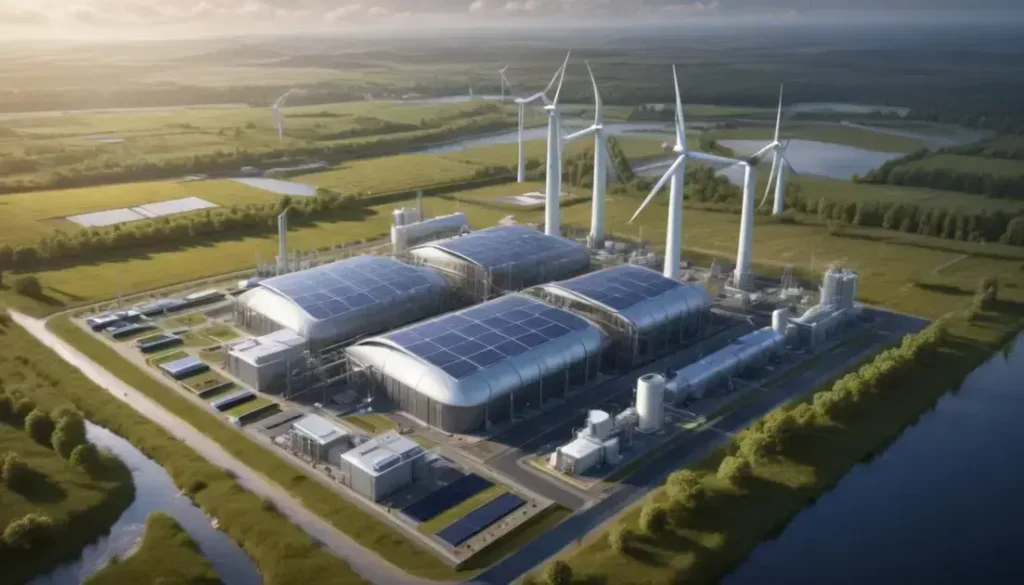Carbon capture technology effectively reduces greenhouse gas emissions by capturing CO2 from industrial sources and storing it safely, contributing to climate change mitigation and supporting sustainable community growth.
Did you know that clean energy advancements like carbon capture technology are set to reshape our energy landscape? In the UK, Balfour Beatty is at the forefront of an innovative project that could have significant implications for Canada.
Introduction to the Teesside Power Project
The Teesside Power Project represents a significant step in advancing clean energy through innovative carbon capture and storage technology. This project involves the construction of a state-of-the-art facility that aims to reduce carbon emissions from gas-fired electricity generation. It serves as a model for similar initiatives worldwide, showcasing how traditional energy sources can evolve.<\/p>
One of the main objectives of the Teesside Power Project is to demonstrate how carbon capture technology can effectively capture greenhouse gases before they enter the atmosphere. By implementing this technology, the project is set to achieve a substantial decrease in overall carbon emissions, promoting a more sustainable energy sector.<\/p>
Moreover, the project is expected to create numerous job opportunities in the region, benefiting the local economy and providing a platform for further investment in clean technology. Key stakeholders, including government bodies and private companies, are collaborating to ensure that the project not only meets environmental goals but also delivers economic advantages to the community.<\/p>
Balfour Beatty’s role in carbon capture
Balfour Beatty plays a pivotal role in advancing carbon capture technology, marking a significant step towards sustainable energy solutions. As one of the leading construction and engineering firms, Balfour Beatty is committed to implementing innovative strategies that align with environmental goals. Their involvement in the Teesside Power Project exemplifies how engineering expertise can contribute to cleaner energy initiatives.
The company focuses on the integration of cutting-edge technology in its projects, particularly in the development of systems that capture greenhouse gas emissions. This integration helps reduce the carbon footprint of energy production, addressing critical concerns regarding climate change. Balfour Beatty’s methodologies ensure that carbon capture processes are efficient and effective, setting a benchmark for future projects.
Moreover, collaboration with governmental and industrial partners enhances Balfour Beatty’s capacity to develop scalable carbon capture solutions. By participating in multidisciplinary teams, the company fosters innovation and accelerates the deployment of sustainable practices within the energy sector. Their ongoing projects not only aim to meet regulatory compliance but also to create a positive impact on communities and environmental health.
The importance of gas-fired power stations
Gas-fired power stations play a crucial role in the global energy landscape, providing a reliable and efficient source of electricity. As the demand for energy continues to rise, these facilities serve as an essential backup to renewable energy sources, such as wind and solar, which can be intermittent.
One of the key benefits of gas-fired plants is their ability to quickly adjust output, making them ideal for meeting peak demand periods. Unlike coal-fired power stations, natural gas facilities emit significantly lower levels of carbon dioxide and other pollutants, making them a cleaner alternative for energy generation.
Moreover, the integration of carbon capture technology in gas-fired power stations further enhances their sustainability. By capturing and storing carbon emissions, these plants can contribute to a reduction in greenhouse gases, aligning with global climate targets. This dual approach supports the transition towards a low-carbon economy while ensuring energy security.
In addition, investments in gas-fired power infrastructure can catalyze economic growth by creating jobs and fostering advancements in technology. As companies look to improve efficiency and sustainability, gas-fired power stations will remain an integral component of the energy mix.
Economic impacts on job creation in Canada
The transition to clean energy and advancements in carbon capture technology have significant economic impacts on job creation in Canada. As industries embrace sustainable practices, new opportunities arise across various sectors, including construction, engineering, and technology.
Investment in infrastructure for projects like carbon capture facilities stimulates local economies by creating skilled labor positions. These jobs not only support construction phases but also require ongoing maintenance and operation, leading to sustained employment over time. The demand for workers proficient in green technologies is rising, highlighting the need for training programs and educational initiatives.
Furthermore, job creation extends beyond the immediate construction workforce. Ancillary industries, such as supply chain management and environmental consulting, also benefit from the growth of clean energy projects. As Canadian businesses adapt to new regulations and sustainability goals, they contribute to a robust job market that supports transitioning workers from traditional sectors.
The ripple effect of clean energy initiatives increases overall employment rates and fosters economic resilience. By prioritizing investments in sustainability, Canada positions itself as a leader in the global shift towards a greener economy, creating a multiplying effect on job availability across the nation.
How carbon capture technology works
Carbon capture technology is designed to reduce the amount of carbon dioxide (CO2) released into the atmosphere from various sources, primarily from industrial processes and power generation. This innovative approach involves three key stages: capture, transport, and storage.
During the capture phase, CO2 is separated from other gases produced during combustion or chemical reactions. This can be achieved using several methods, including absorption with solvents, adsorption using porous materials, or membrane separation. Each technique has its advantages, depending on the specific application and the concentration of CO2 in the gas stream.
Once captured, the CO2 is compressed and transported to a storage site, often via pipelines. During this transport phase, it is crucial to ensure that the CO2 remains in a liquid state to prevent leakage. Monitoring systems are implemented to track the integrity of the transportation method.
The final step involves permanent storage in geological formations deep underground, such as depleted oil and gas fields or deep saline aquifers. This process prevents the CO2 from re-entering the atmosphere, contributing to significant reductions in greenhouse gas emissions. By utilizing carbon capture technology, industries can transition towards more sustainable practices while still relying on traditional energy sources.
Government initiatives supporting clean energy
Government initiatives play a vital role in promoting clean energy solutions and driving the transition to a low-carbon economy. In Canada, various policies and programs support the development and implementation of renewable energy technologies. These efforts aim to reduce greenhouse gas emissions and enhance energy security while creating job opportunities.
One significant initiative is the Investment Tax Credit, which provides financial incentives for companies investing in renewable energy projects. This credit helps to offset initial costs, encouraging businesses to adopt solar, wind, and other clean technologies. Additionally, government funding programs offer grants and loans to help startups and established companies launch innovative clean energy projects.
Moreover, the federal and provincial governments have implemented regulatory frameworks that establish renewable energy targets and promote energy efficiency. By setting ambitious goals, such as achieving net-zero emissions by 2050, Canada is positioning itself as a leader in the global clean energy market. Programs like the Clean Growth Program further support research and development in clean technologies, fostering innovation and collaboration across sectors.
Through these initiatives, the government not only enhances public awareness of clean energy benefits but also engages communities in adopting sustainable practices. This collaborative approach is crucial for achieving Canada’s environmental goals and ensuring a resilient energy future.
Teesside’s significance for Canadian businesses
The Teesside Power Project holds substantial significance for Canadian businesses as it serves as a model for integrating innovative clean energy practices within traditional sectors. This project highlights the potential of carbon capture technology, which is key to reducing greenhouse gas emissions while maintaining energy production efficiency.
For Canadian companies, particularly in industries such as energy, manufacturing, and construction, the successful implementation of similar projects poses a chance to enhance their operational sustainability. By learning from Teesside’s strategies, these businesses can adopt advanced technologies that improve their environmental impact without sacrificing profitability.
Furthermore, collaboration with international partners involved in the Teesside project encourages knowledge sharing and innovation. This exchange can facilitate the development of best practices and inspire further investments in clean technology initiatives within Canada. As Canadian firms strive to meet increasing regulatory pressures and consumer demand for sustainability, exposure to projects like Teesside is invaluable.
Ultimately, the significance of Teesside extends beyond its immediate geographical location, providing a framework for Canadian businesses to navigate the complex landscape of clean energy solutions. By leveraging insights gained from such projects, companies can position themselves as leaders in the transition towards a greener economy.
Future projections for carbon capture
Future projections for carbon capture technology indicate a significant impact on reducing global carbon emissions. As governments and industries increasingly focus on sustainability, the demand for effective carbon capture solutions is expected to grow. By 2030, estimates suggest that carbon capture usage and storage (CCUS) could mitigate approximately 1.5 billion tonnes of CO2 emissions annually across various sectors.
Advancements in technology will play a crucial role in enhancing the efficiency and affordability of carbon capture systems. Innovations such as direct air capture and improved materials for capturing CO2 are being developed, enabling wider applications in manufacturing and energy production. These developments aim to lower costs and increase the scalability of carbon capture solutions.
Moreover, the integration of carbon capture with renewable energy sources presents opportunities for creating negative emissions technologies, which actively remove CO2 from the atmosphere. This integration can support efforts to achieve international climate targets, such as those outlined in the Paris Agreement.
The collaboration between governments, private companies, and research institutions will be essential in driving the future of carbon capture technology. With continued investment and innovation, the future landscape of carbon capture could transform industries and contribute significantly to global climate goals.
Comparative analysis with Canadian energy projects
A comparative analysis of the Teesside Power Project with Canadian energy initiatives reveals important insights into the effectiveness of carbon capture and renewable energy integration. Both regions are pushing the envelope in the field of sustainable energy, yet they adopt different approaches based on local resources and regulatory frameworks.
In Canada, projects like Boundary Dam in Saskatchewan have pioneered carbon capture technology in the coal sector. This project demonstrates a successful model by capturing over 90% of CO2 emissions from a coal-fired power station, making it a direct counterpart to the gas-fired technologies employed in Teesside. Both projects showcase the potential for carbon capture solutions to play a pivotal role in meeting climate targets.
Additionally, while the Teesside project focuses on integrating carbon capture with natural gas, Canadian initiatives increasingly emphasize the use of renewable energy sources, such as wind and solar. This creates a more diverse energy portfolio, allowing Canada to leverage its abundant natural resources for cleaner energy production.
The comparative analysis also highlights the importance of government support and investment in fostering innovation. In both regions, successful outcomes hinge on collaboration between public and private sectors to drive sustainable practices forward. By learning from each other’s successes and challenges, both the UK and Canada can enhance their contributions to a sustainable energy future.
Challenges in implementing carbon capture
Implementing carbon capture technology presents several significant challenges that need to be addressed to maximize its effectiveness. One of the primary obstacles is the high cost associated with the installation and operation of carbon capture systems. These systems require advanced technology and infrastructure, which can be prohibitively expensive for many companies, especially in regions with limited financial resources.
Another challenge is the scale of deployment. To make a meaningful impact on carbon emissions, carbon capture solutions must be implemented at a large scale. This requires substantial investment, coordination among multiple stakeholders, and long-term commitment from both the public and private sectors.
Additionally, there are technical hurdles related to the efficiency and reliability of carbon capture processes. Issues such as capturing CO2 from dilute sources remain problematic. The energy required to operate these systems can offset some of the emissions reductions achieved, which raises questions about the overall sustainability of the technology.
Moreover, regulatory and policy frameworks can complicate the implementation of carbon capture projects. Uncertain regulations or lack of supportive policies can deter investment and slow down progress. Achieving buy-in from various stakeholders, including local communities and environmental groups, is crucial for the success of these initiatives. Overcoming these challenges is essential for advancing carbon capture as a viable solution in the global fight against climate change.
Community and environmental benefits
Implementing carbon capture technology offers numerous community and environmental benefits that significantly enhance local ecosystems. One of the primary advantages is the reduction of greenhouse gas emissions, which helps mitigate the effects of climate change. By capturing and storing CO2, communities contribute to global efforts to achieve climate targets, fostering a healthier environment for future generations.
In addition to environmental benefits, local communities can experience economic growth as a direct result of carbon capture initiatives. The establishment of carbon capture facilities often leads to job creation in various sectors, including construction, technology, and maintenance. This employment boost can revitalize communities, creating new opportunities for local workers.
Furthermore, carbon capture projects can improve air quality by reducing the levels of harmful pollutants released into the atmosphere. Enhanced air quality contributes to better health outcomes for community members, reducing respiratory illnesses and improving overall quality of life.
Community engagement is vital for the success of carbon capture projects. Stakeholder involvement can lead to greater awareness and support for sustainability initiatives. By fostering collaboration between industries and local residents, these projects can ensure that environmental and community needs align, providing mutual benefits that support long-term sustainability.
In summary, understanding carbon capture technology
Carbon capture technology is an essential tool in the fight against climate change. It not only helps reduce greenhouse gas emissions but also provides significant benefits to both communities and the environment.
As we’ve explored, carbon capture creates job opportunities, enhances air quality, and supports sustainable practices. By investing in this technology, we can foster a cleaner, healthier future for our communities while addressing pressing environmental challenges.
The collaboration between government, industry, and local communities will be crucial for the successful implementation of carbon capture projects. Together, we can create a greener economy that benefits everyone.
Embracing carbon capture as part of our strategy to combat climate change is not just a necessity; it is an opportunity to build a sustainable future.
Frequently Asked Questions
What is carbon capture technology?
Carbon capture technology refers to processes that capture and store carbon dioxide emissions from sources like power plants, preventing them from entering the atmosphere.
Why is carbon capture important for the environment?
Carbon capture is crucial because it helps reduce greenhouse gas emissions, combating climate change and contributing to cleaner air and improved public health.
How does carbon capture benefit local communities?
It creates job opportunities in construction and technology sectors, enhances air quality, and encourages local investment in sustainable practices.
What are some challenges in implementing carbon capture technology?
Challenges include high costs, the need for large-scale deployment, technical reliability, and navigating complex regulatory frameworks.
How does carbon capture impact economic growth?
Carbon capture can stimulate economic growth by creating jobs, attracting investment, and fostering innovation in clean technology sectors.
What role do governments play in carbon capture initiatives?
Governments provide funding, set regulations, and create policies that support the development and deployment of carbon capture technologies.


